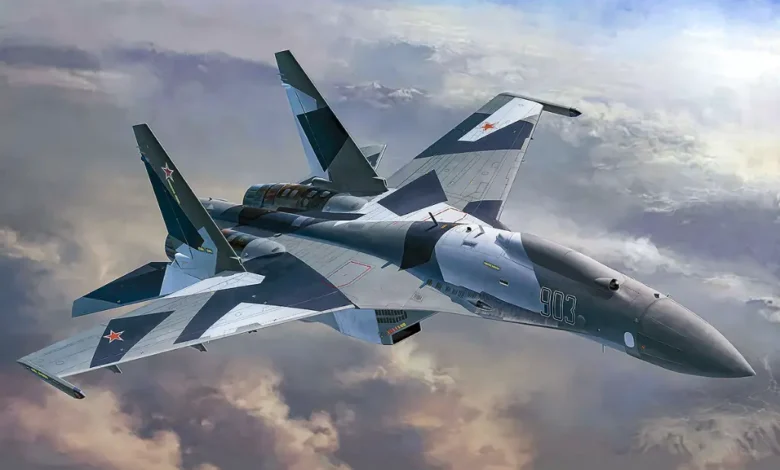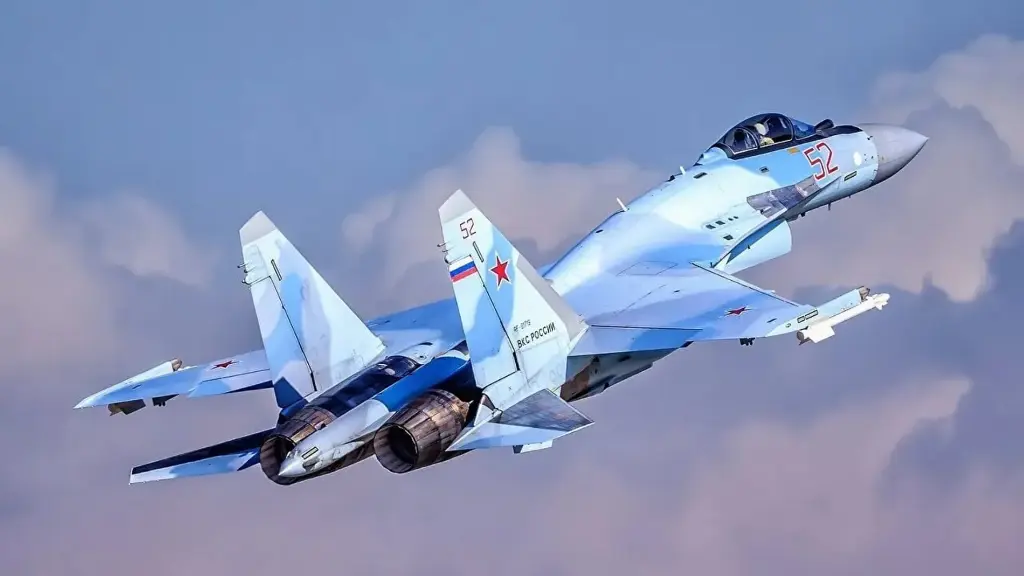Sukhoi Su-35

The Sukhoi Su-35 is a highly advanced, multirole fighter aircraft developed by Sukhoi for the Russian Air Force. Based on the Su-27 platform, the Su-35 features significant upgrades in avionics, engines, and weapons systems. First flown in 2008 and introduced in 2014, the Su-35 is designed for air superiority and ground-attack missions, offering exceptional maneuverability and combat capabilities.
Fact Sheet
| Role | Multirole fighter |
|---|---|
| Manufacturer | Sukhoi |
| First Flight | 2008 |
| Service Entry | 2014 |
| Crew | 1 |
Specifications
| Length | 21.9 m (72 ft) |
|---|---|
| Wingspan | 15.3 m (50 ft 2 in) |
| Height | 5.9 m (19 ft 4 in) |
| Empty Weight | 18,400 kg (40,565 lb) |
| Max Takeoff Weight | 34,500 kg (76,060 lb) |
| Powerplant | 2 × Saturn AL-41F1S turbofans |
| Thrust | 31,900 lbf (142 kN) per engine with afterburner |
| Max Speed | Mach 2.25 (2,400 km/h; 1,490 mph) |
| Service Ceiling | 20,000 m (65,600 ft) |
| Range | ~2,200 mi (3,600 km) combat radius |
| Rate of Climb | ~55,000 ft/min (280 m/s) |
Avionics & Armament
| Main Radar | Irbis-E PESA radar |
|---|---|
| Avionics | Advanced avionics suite, electronic warfare systems |
| Armament | One 30-mm GSh-30-1 cannon (150 rounds); Up to 12 external hardpoints for: – Air-to-air missiles (R-77, R-73) – Air-to-ground munitions (Kh-31, Kh-29, bombs) – Precision-guided bombs – External fuel tanks |
Notable Features
- Supermaneuverability with thrust vectoring engines.
- Advanced avionics for superior situational awareness.
- Multirole capability for air-to-air and air-to-ground missions.
- High payload capacity for extended combat missions.
- Widely exported to allied nations.

The Sukhoi Su-35 (NATO reporting name: Flanker-E) is a formidable Russian 4++ generation multi-role fighter that represents a significant evolution of the legendary Su-27 “Flanker” air superiority fighter. Designed to bridge the gap between fourth-generation jets and stealthy fifth-generation aircraft like the Su-57, the Su-35 combines incredible maneuverability with advanced avionics and a potent weapons load, making it a serious contender in modern aerial combat.
From Air Superiority to Multi-Role Powerhouse: The Su-35’s Development
The journey of the Su-35 began with a deep modernization of the Su-27, aiming to significantly enhance its combat effectiveness against a wide range of targets – air, land, and sea. The initial “Su-35” designation was applied to a different, earlier derivative of the Su-27 in the late 1980s, which featured canards and was known as the Su-27M.
The modern Su-35S (the production version for the Russian Aerospace Forces) is the result of a second, more comprehensive modernization effort initiated in 2003. This version incorporates advanced technologies from the developmental Su-57 program. The first prototype of this current Su-35 made its maiden flight on February 19, 2008. Although initially designed with export in mind, the Russian Air Force became the launch customer in 2009.
The Defining Features: What Makes the Su-35 So Capable?
The Su-35 is a single-seat, twin-engine aircraft known for several key attributes:
- Supermaneuverability: This is arguably the Su-35’s most eye-catching feature. It’s powered by two upgraded Saturn AL-41F1S afterburning turbofan engines, which incorporate three-dimensional thrust-vectoring nozzles. This means the engine exhaust can be directed in multiple directions, allowing the Su-35 to perform incredible, seemingly impossible aerial maneuvers like the “Pugachev’s Cobra” and “Kulbit.” While these maneuvers might seem like aerobatic stunts, they can provide a tactical advantage in close-range combat by allowing rapid changes in direction and angle of attack, potentially evading missile locks or gaining a firing solution.
- Advanced Radar (Irbis-E PESA): At the heart of its sensor suite is the N035 Irbis-E passive electronically scanned array (PESA) radar. This powerful radar is capable of detecting aerial targets with a 3 square meter radar cross-section (RCS) at ranges of up to 400 km (249 miles) in certain modes. It can track up to 30 targets simultaneously and engage up to 8 targets at once, giving the pilot superior target acquisition and tracking capabilities for beyond-visual-range (BVR) combat.
- Integrated Avionics and Situational Awareness: While not true “sensor fusion” in the same way as fifth-generation fighters, the Su-35 features a highly integrated avionics suite. This includes the OLS-35 infra-red search and track (IRST) system, which can passively detect heat signatures of aircraft at significant ranges without emitting radar signals, making it an “anti-stealth” tool. It also has a modern “glass cockpit” with large multi-function displays and a helmet-mounted display system, enhancing pilot situational awareness.
- Robust Electronic Warfare (EW) Suite: The Su-35 is equipped with the L175M Khibiny-M electronic countermeasures (ECM) system. This comprehensive EW suite helps detect and jam enemy radar signals, improving the aircraft’s survivability against modern air defenses and opposing fighters.
- Heavy Payload and Diverse Armament: The Su-35 is a true multi-role platform, capable of carrying a massive payload of up to 8,000 kg (17,637 pounds) on its 12 hardpoints. Its arsenal includes:
- Air-to-Air Missiles: A wide range of Russian air-to-air missiles, such as the long-range R-77-1 (radar-guided) and the highly agile R-73/74 (infrared-guided). There are also reports of integration with the very long-range R-37M missile.
- Air-to-Surface Missiles: Various types of precision-guided munitions like the Kh-29L/TE, Kh-31A/P (anti-ship/anti-radiation), Kh-35U, and Kh-59M standoff missiles.
- Guided and Unguided Bombs: Including KAB-500S satellite-guided bombs and various conventional bombs.
- Internal 30mm Cannon: A GSh-30-1 cannon with 150 rounds for close-in engagements.
Combat Record and Operators
The Su-35S has seen significant combat action, particularly in:
- Syria: Su-35S jets have been deployed to Syria since 2016, providing air cover for ground forces, conducting precision airstrikes, and engaging in air policing missions. They have reportedly deterred Turkish and Israeli incursions.
- Ukraine War: The Su-35S has been actively involved in the ongoing conflict in Ukraine. It has been used to provide air cover for other Russian aircraft, conduct long-range precision strikes (often using standoff weapons like the Kh-59), and attempt to suppress Ukrainian air defenses. While Russia has suffered some losses of Su-35s in Ukraine (reportedly 8 confirmed losses through open-source imagery as of June 2025, though the exact circumstances are often debated), the aircraft remains a potent threat, particularly in beyond-visual-range engagements with its advanced radar and missiles. There have been unconfirmed reports of Ukrainian F-16s possibly engaging Su-35s, but clear, verified air-to-air combat victories involving the Su-35 are rare and hotly contested.
The primary operator of the Sukhoi Su-35 is the Russian Aerospace Forces.
For export, the Su-35 has seen some success, but also faces stiff competition:
- China: The People’s Liberation Army Air Force (PLAAF) acquired 24 Su-35s, largely for testing and to gain experience with its advanced features and engines, which have undoubtedly influenced their own domestic fighter development.
- Algeria: In a recent development (confirmed in April 2025), Algeria has become a new customer for the Su-35, reportedly receiving aircraft that were originally built for Egypt but undelivered due to U.S. sanctions pressure. The exact number is unconfirmed but likely involves at least some of the 24 jets.
Other countries, including Iran and Indonesia, have shown interest in the Su-35, but deals have faced various political and financial obstacles.
The Future of the Flanker-E
The Sukhoi Su-35 remains a formidable and relevant fighter aircraft. Its combination of extreme maneuverability, powerful radar, and substantial weapons payload makes it a serious challenge for even some modern Western fourth-generation fighters, particularly in a short-range engagement. While it lacks the full stealth of fifth-generation aircraft, its ability to carry a large number of long-range missiles and its advanced EW suite allow it to operate effectively in contested airspace.
With ongoing production for the Russian Aerospace Forces and new export deals emerging, the Su-35 Flanker-E will continue to be a significant player in global air power for the foreseeable future, representing a powerful and versatile option in the non-stealth fighter market.



